Leaving Home
I´m always a little sad to leave home but at 4.45 p.m. on Sunday, 28th February 2016, John J. picked me up to take me to Terminal 3 at the hated (by me, at any rate) Heathrow. Here, I boarded flight JJ8085 to Sao Paulo, Brazil. This was a Boeing 777-300 operated by the Bazilian carrier TAM, with whom I´ve not flown before. Before boarding, I made a quick visit to the British Airways Galleries Lounge which TAM passengers use because TAM are part of the ´One World´consortium. We commenced taxiing about right time (21:15) and made our way to the inevitable take-off queue. Runway 09R was in use for take-offs.
Well, the crew were friendly enough but I´ve been rather spoiled by recent flights with Quatar Airways and Emirates - the TAM equipment was not quite so modern, the menu not quite as comprehensive. The aircraft did have video on demand, but I couldn´t get it to work properly, so I had the novel experience of watching part of the recent James Bond film ´Spectre´ with no sound track and subtitles in Portuguese (Brazil´s main language). However, the seat went properly flat for sleeping, so I actually managed some periods of shut-eye, but I still found the eleven-and-a-bit hour flight tiring.
I´ve transited through Sao Paulo International once before. I didn´t enjoy that experience and the second attempt was no better. We arrived at the stand about 06:00 but, for some reason, it took over ten minutes to get the air bridge connected. The airport had been thoroughly rebuilt and enlarged since my first visit which meant that, despite moving walkways in places, the amount of walking was horrendous. I knew I wanted connecting flight JJ8018 for Buenos Aires and Heathrow has issued my boarding pass, but none of the departure screens showed the gate - just saying ´Check-in at area F´. Direction signage was in English and Portuguese but I found the positioning confusing. I realised I´d taken a wrong turn because what I thought was ´Transfer to International Departures´ appeared to lead only to 'Domestic Departures'. I retraced my steps to discover that the queue of hundreds of people which I'd thought was for the enquiry desk was actually the queue I wanted for Security before you could get back to International Departures.
This report was sent from Sao Paulo International Airport, which markets itself as ´GRUAirport´ ('GRU' is the ticketing code for the airport). I unkindly concluded that ´GRU´ might be short for ´Gruesome´. Rant over (for a while).
Related posts
Next South Atlantic post.
All my South Atlantic posts.
My pictures
There are a few pictures of the trip in the album South Atlantic Voyage.
You can find all my pictures on the trip in the Collection Cape to Cape (still being added to, at the time of writing).
['Cape to Cape' collection added 2-Apr-2016]
Monday, 29 February 2016
Friday, 19 February 2016
Return to Blackpool and Fleetwood (part 1)
I've been to Blackpool many times. The earliest trip in this blog here recollects a steam-hauled trip in 1957. My trip in January 2014 is described here and there's a later post about railways around Blackpool here. On 13th February 2016, I thought it was time to go back.
The journey to Blackpool didn't go quite to plan so 'part 1' only describes getting there. Much later, I added 'part 2' here describing my (literally) pedestrian explorations in Blackpool and Fleetwood.
Click on any image below for 'uncropped' view, or search 'My pictures' to view or download in various sizes.
By train to Crewe
Relying on the local bus to reach the station at Wolverhampton, the earliest train I could catch north was the 07:54 London Midland Class 350 Electric Multiple Unit to Liverpool. This took me as far as Crewe. With stops at Penkridge and Stafford, this is allowed 36 minutes to Crewe, six minutes longer than the later Virgin 'Pendolino' at 08:37 from Wolverhampton which is non-stop. With a slack through Norton Bridge (probably because of the ongoing project to construct a flyover junction here) and the seemingly-obligatory stop at Crewe South Junction waiting for signals, we may have been a couple of minutes late arriving.
Whilst we waited for the signal, I mused about the long-gone mechanical signal box at Basford Wood, in between Basford Hall Junction (still, amazingly, a signal box) and Crewe South Junction. Basford Wood controlled a facing connection from the Down Slow to the Down Goods Line and connections from the Up Goods Line (and the Carriage Shed) to either the Up Fast or Up Slow. The trailing connection to the Up Fast remains, controlled by a Ground Frame.
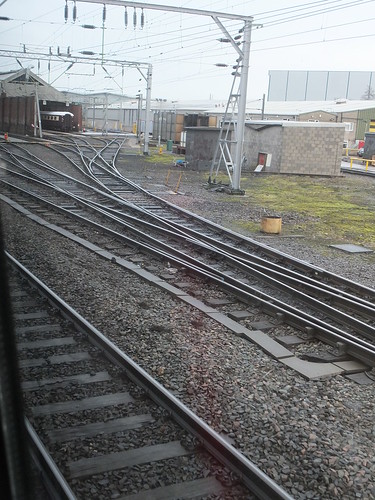
2014 View of the former Carriage Shed on the Up side, latterly the LNWR depot, from the south. Note the two tandem turnouts ('triple leads').
The facing connection from the Down Slow was removed but track of the former Down Goods line remains, still featuring the original bullhead rail. A buffer stop has been placed partway along the line and north of this buffer stop is now called a Down Siding, with a trailing connection back to the Down Slow at Crewe South Junction. I don't think the siding gets much use but I spotted a Virgin-liveried passenger coach parked there a while ago.
 Crewe: South Junction: Stop block on former Down Loop.
Crewe: South Junction: Stop block on former Down Loop.
The derelict structure of Crewe South Junction signal box remains, as a permanent rebuke to Network Rail. As a reinforced-concrete 'Air Raid Precautions' design, I suppose it's regarded as too expensive to remove, like the numerous concrete World War II fortifications which still litter the country. There's a bit more about Crewe South Junction signal box here.
On arrival at Crewe, I had to wait for the later 08:37 from Wolverhampton to catch up with me. This train was due to go forward at 09:09, arriving Preston at 09:52, giving me around half an hour to leave the station and explore.
Crewe Signalling Centre
Crewe Signalling Centre was supposed to be a 'temporary' affair, presumably accounting for its appearance which I always think looks like a B & Q warehouse. Hiding behind a tall galvanised fence on the site of Crewe North locomotive shed, I've never been able to get a reasonable picture from the railway so I thought I might just have time to leave the station and get a closer look from the nearby housing estate. As I got nearer the railway, there was a forest of standard galvanised railway fencing extending in all directions, marking out the railway boundary, the public car park and the railway staff car park. As I was about to give up, I came upon a spot when one fence panel had been neatly removed and laid to one side. I don't know why, but it could have been to provide an unofficial walking route to the staff car park.
Passing through the opening, I came to the rather forbidding compound of Crewe Signalling Centre, with its extra-tall barbed-wire topped fence, numerous lighting standards with high-intensity lighting fittings and tall poles with surveillance cameras. To prevent 'ram-raiding', a regular series of tough-looking bollards had been set up all around the periphery of the compound inside the fence. Entrance to the compound was via a serious-looking automatic gate with an intercom and card reader. There was space inside the compound for vehicle parking and the end of the building near the parking area was protected by 'Armco' barriers. I concluded this was a defence against employees' poor driving, rather than against 'enemy action'. I managed a few pictures which don't add a lot but do show two Relocatable Equipment Buildings (REBs) in the compound, one provided with a fire suppression system, judging by the external warnings (Since fire suppression systems seek to extinguish or limit fire by the exclusion of oxygen, it's essential that the systems be isolated before staff carry out work in these areas).
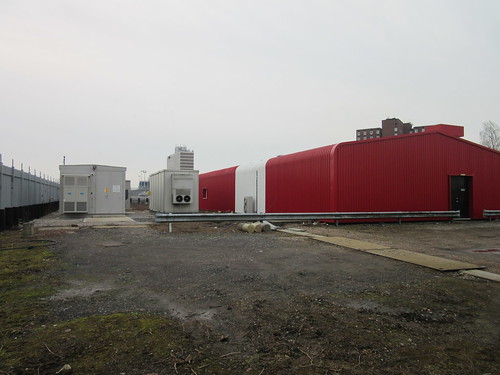 Crewe Signalling Centre (R), with two Relocatable Equipment Buildings (L).
Crewe Signalling Centre (R), with two Relocatable Equipment Buildings (L).
Before returning to the station, I took a picture of the old Cable Bridge which runs across Crewe North Junction and a much newer Cable Bridge I'd not really noticed before (although it shows up on a number of my pictures).
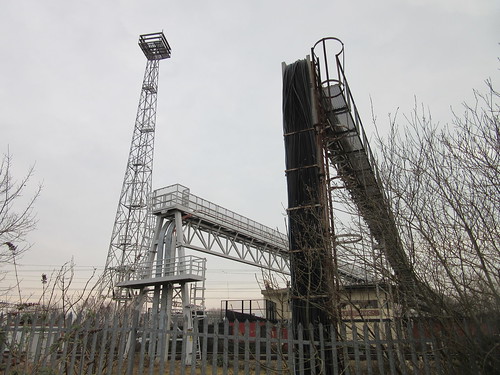 Crewe North Junction: Cable Bridges - New (L), Old (R). The preserved former Crewe North Junction signal box is in the background.
Crewe North Junction: Cable Bridges - New (L), Old (R). The preserved former Crewe North Junction signal box is in the background.
Bewilderment at Crewe
Back at the station, the departure displays suggested my train was already in platform 11 and, indeed, a 'Pendolino' was standing there, with doors open. But there seemed a lot of people hanging about on the platform, rather than boarding. There was an announcement on the public address as I made my way to the platform but coverage at Crewe is rather patchy and I couldn't make it out. The electronic displays mounted in the slidin-plug doors of the train gave the destination as Liverpool. I heard part of an announcement by the Conductor/Guard over the train public address talking about cancellation of the train which would now return to London. If passengers wanted to "abandon their journey" and go back, they were told not to worry about ticket validity. Clearly something was badly amiss. The platform display had changed to show my train as 'Delayed'. The station public address was silent and the platform staff had disappeared. The platform enquiry office had two harrassed looking staff slowing working through a long queue of worried passengers which snaked all the way round the outside of the building. A station cleaner I knew believed the emergency services were dealing with a incident to the north of Crewe.
Trains did not appear to be running on the Manchester line because of planned engineering work. There was one departure shown to Manchester Oxford Road only, but it suddenly got cancelled according to the platform display, without explanation. It was only later I realised that, denied the normal route from Crewe, this train had been scheduled to travel via Warrington and join the Liverpool and Manchester line to Oxford Road, hence the lack of intermediate stops.
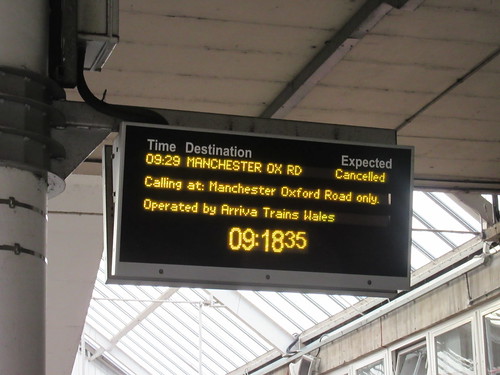 Suddenly cancelled Manchester service.
Suddenly cancelled Manchester service.
I realised that Liverpool could be reached by taking a Chester train and then the 'Merseyrail' electrics to Liverpool (as I'd done previously, for instance as described in Birkenhead and New Brighton by train (Part 1)). I vaguely wondered whether to attempt Liverpool this way but, by the time I'd reached the platform, the 2-coach diesel multiple unit was absolutely packed, with a crowd of disconsolate people still on the platform, faced with waiting for a later service.
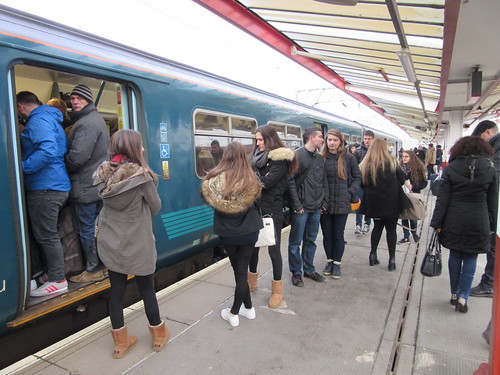 Overloaded Chester service.
Overloaded Chester service.
Eventually a couple of Virgin staff appeared on the platform and attempted to give some information to the waiting throng. There had apparently been a fatality at Acton Bridge which the emergency services were attending and there would be no trains to or from the north until this was dealt with. One member of Virgin staff acquitted himself, I thought, very well remaining cheerful under the barrage of questioning and trying to make helpful suggestions as to how people might continue their travel or return to their starting point. A train had hit and killed a person at Acton Bridge, he said, adding that Emergency Services are allowed to close a line, in the first instance, for up to three hours but that if it's a straightforward suicide the closure can be as short as one hour.

Bewilderment at Crewe: Virgin staff try to help.
I was surprised that there wasn't chaos, there wasn't apparent anger, just resignation and bewilderment. From time to time, the departure displays would change, replacing one set of incorrect information with a different set of wrong information. Nothing arrived from the north, but various trains arrived from the south and disgorged their passengers. The strategy appeared to be to turn these trains round and send them back. With the unknown delay in getting a train to my intended destination, I wondered whether to head back home.
The 10:02 London Midland Service to Euston via Stoke would have taken me at least as far as Stafford and, since this train was already standing in platform 3 Bay, staff were enthusiastically directing Southbound passengers to it. The train was already fairly full but I couldn't see a Guard or a Driver so I hovered near the open door. Just after ten o'clock, the signal cleared, so I wondered if I was wrong but, after a couple of minutes inactivity, a member of station staff came to find out what the delay was. "I don't think we've got a crew" I said, as he went to check the driver's cab. A minute later, the signal went back to red so, letting a nearby passenger know, I 'bailed out'. The station staff didn't update the waiting passengers and, of course, without a driver or guard, there was no on-train announcement but by the time I'd got level with the nearest platform departure display, it had changed from '10:02 Euston' a few minutes earlier to '11:02 Euston'.
Whilst this little fiasco was being played out, I'd noticed a 'Class 350' arrive from the south and, unusually, run into the little-used platform 12. A few minutes later, a second 'Class 350' followed, also into platform 12. I pointed out to the Virgin staff that their assurances on the 10:02 had not worked out but they were equally confident that the train "already waiting in platform 12" would soon be heading south. The 'Pendolino' which had been occupying platform 11 departed south for Milton Keynes and Euston and the platform departure display immediately changed to show '10:09 Preston'. Very mistrustful of this information, I started to make my way to platform 12 for the southbound train when a non-stop 'Pendolino' roared through on the Down Through line. Does that mean, I wondered, that the line has been re-opened? I returned to platform 11 and, about ten minutes late, what was to be the 10:09 Preston pulled into the crowded platform. I boarded and didn't even attempt to locate a seat on the packed train but located myself by the small window of the left-side sliding-plug automatic door at the rear of the quiet coach, resigned to standing to Preston.
 Bewilderment at Crewe: Arrival of 10:09 to Preston.
Bewilderment at Crewe: Arrival of 10:09 to Preston.
The tragic cause of all this was probably not the fault of any of the many railway organisations involved but I do blame them all for the inept handling after the cause and, particularly, for the lack of accurate and timely information to the bewildered passengers.
Continuing to Blackpool
We made reasonable speed as we left Crewe. Beyond Hartford, I noticed a 'Class 350' stationary on the Down Slow, just before the Down Slow and Down Fast converge into a single Down line through Acton Bridge station as far as Weaver Junction. Later, I realised that this was very probably the 07:54 from Wolverhampton to Liverpool I'd travelled on as far as Crewe. This should have passed through Acton Bridge at about 08:45 so it was most likely the train involved in the fatality. Our speed was slightly reduced through Acton Bridge, then we sped through Weaver Junction, where the Liverpool Line diverges to the left.
We were soon approaching the Manchester Ship Canal. There are some historic disused railway bridges on the Up side I've not yet managed to photograph. The original line ran at a lower level under these bridges but, to obtain the necessary clearance for ships when the Manchester Ship Canal was built between 1887 and 1894, a deviation line was constructed to the west with a rising gradient leading to the bridge. I discussed a similar deviation required by the construction of the Manchester Ship Canal further east, at Irlam, in the post By Train to Irlam. As we rattled across the ship canal bridge, I could see Fiddler's Ferry coal fired power station, recently in the news as the owners, SSE plc, announced the intended closure of 3 of the 4 generating units here in April 2016.
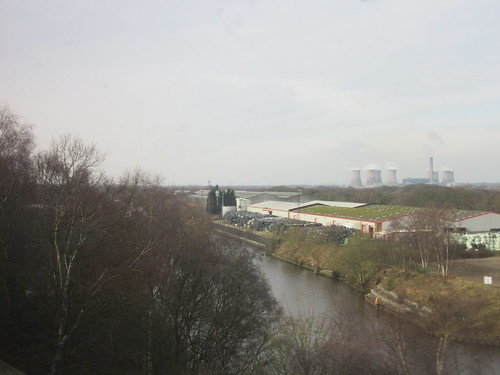 Crossing the Manchester Ship Canal at Acton Grange, with Fiddler's Ferry Power Station in the background.
Crossing the Manchester Ship Canal at Acton Grange, with Fiddler's Ferry Power Station in the background.
Our stop at Warrington Bank Quay was a little longer than normal, because of the number of people getting off and on. Then, we were off again. A few minutes after leaving Warrington, near Newton-le-Willows, we entered a sandstone cutting to dive under the Liverpool and Manchester Railway, 'the first inter-city railway in the world'. I've not yet managed a reasonable picture when passing through the cutting but the picture below was taken when passing over the top on 27th July 2013 when I was off to the Museum of Science and Industry in Manchester at the end of a rather crowded few days described in the post A Busy Week.
 A view taken in 2013 from the Liverpool and Manchester Railway, showing the West Coast Main Line passing under in a sandstone cutting near Newton-le-Willows.
A view taken in 2013 from the Liverpool and Manchester Railway, showing the West Coast Main Line passing under in a sandstone cutting near Newton-le-Willows.
Our next stop was Wigan North Western and, as we left, we passed over the former Lancashire and Yorkshire Railway, with its diverging routes from Wigan Wallgate to Kirkby (change for Liverpool) on the left and Southport on the right. A trip including both of these routes is described in Day Trip to Southport and Liverpool (Part 1) and Day Trip to Southport and Liverpool (Part 2).
 Wigan Wallgate Junction.
Wigan Wallgate Junction.
We made a fairly spirited run to Preston but were still about as late arriving as the departure from Crewe had been. I quickly made my way to platform 1 for the next Blackpool service - a Northern Rail train stopping at Kirkham, Poulton-le-Fylde, Layton and Blackpool North.
Whilst I waited with the large crowd on the platform for the arrival of the Blackpool train, a Northern Rail single-car 'Class 153' service from Ormskirk arrived on the other side of the island platform, platform 2, discharged its passengers and quickly loaded up, ready to go back to Ormskirk. I described using this line in the post Preston to Liverpool by Rail. My train arrived a few minutes late, one of the dreadful 2-car 'Class 142' units, first introduced in 1985, which still live on although they should never have been foist on an unsuspecting public in the first place. I was lucky in getting a seat for the journey - quite a number of passengers were forced to stand. With 4-wheel, long-wheelbase coaches we 'lolloped' along to Blackpool in what has been politely described as 'nodding donkey' fashion (I'm sure less-complimentary descriptions must exist). With such a crowded train, I couldn't see too much on the journey. I was just glad to arrive in Blackpool at around ten to twelve, when earlier it seemed doubtful I'd make it at all.
Book References
[ 1] ‘British Railways Layout Plans of the 1950’s - Volume 1: ex-LNWR main line, Euston to Crewe’ (Signalling Record Society) ISBN: 1 873228 00 7.
[ 2] ‘British Railways Layout Plans of the 1950’s – Volume 5: ex-Lancashire & Yorkshire Railway Lines in West Lancashire’ (Signalling Record Society) ISBN: 1 873228 04 X.
[ 3] ‘British Railways Layout Plans of the 1950’s – Volume 6: West Coast Main Line (Euxton Junction to Mossband) and Branches’ (Signalling Record Society) ISBN: 1 873228 00 7.
[ 4] ‘British Railways Layout Plans of the 1950’s - Volume 9: LNW Lines Crewe to Euxton Junction, Liverpool to Manchester (and associated branches)’ (Signalling Record Society) ISBN: 1 873228 11 2.
[ 5] ‘Railway Track Diagrams Book 4: Midlands & North West’ (TRACKmaps: 4th edition) ISBN 978-0-9549866-7-4.
[ 6] ‘Along LMS Routes’ by Bill Hudson, Volume 1 Central & Western Divisions (Headstock Publications) ISBN 0 9512793 4 3.
The posts Railways around Blackpool and Railways around Preston list further books.
Related articles in this blog
Halfex to Blackpool.
A Trip to the Seaside.
Railways around Blackpool.
Railways around Preston.
Wolverhampton to Preston by rail.
Return to Blackpool and Fleetwood (part 2).
My pictures
Stafford Area rail.
Crewe Area rail.
Warrington Area rail.
Railways around Preston.
Blackpool's Railways.
The journey to Blackpool didn't go quite to plan so 'part 1' only describes getting there. Much later, I added 'part 2' here describing my (literally) pedestrian explorations in Blackpool and Fleetwood.
Click on any image below for 'uncropped' view, or search 'My pictures' to view or download in various sizes.
By train to Crewe
Relying on the local bus to reach the station at Wolverhampton, the earliest train I could catch north was the 07:54 London Midland Class 350 Electric Multiple Unit to Liverpool. This took me as far as Crewe. With stops at Penkridge and Stafford, this is allowed 36 minutes to Crewe, six minutes longer than the later Virgin 'Pendolino' at 08:37 from Wolverhampton which is non-stop. With a slack through Norton Bridge (probably because of the ongoing project to construct a flyover junction here) and the seemingly-obligatory stop at Crewe South Junction waiting for signals, we may have been a couple of minutes late arriving.
Whilst we waited for the signal, I mused about the long-gone mechanical signal box at Basford Wood, in between Basford Hall Junction (still, amazingly, a signal box) and Crewe South Junction. Basford Wood controlled a facing connection from the Down Slow to the Down Goods Line and connections from the Up Goods Line (and the Carriage Shed) to either the Up Fast or Up Slow. The trailing connection to the Up Fast remains, controlled by a Ground Frame.

2014 View of the former Carriage Shed on the Up side, latterly the LNWR depot, from the south. Note the two tandem turnouts ('triple leads').
The facing connection from the Down Slow was removed but track of the former Down Goods line remains, still featuring the original bullhead rail. A buffer stop has been placed partway along the line and north of this buffer stop is now called a Down Siding, with a trailing connection back to the Down Slow at Crewe South Junction. I don't think the siding gets much use but I spotted a Virgin-liveried passenger coach parked there a while ago.
 Crewe: South Junction: Stop block on former Down Loop.
Crewe: South Junction: Stop block on former Down Loop.
The derelict structure of Crewe South Junction signal box remains, as a permanent rebuke to Network Rail. As a reinforced-concrete 'Air Raid Precautions' design, I suppose it's regarded as too expensive to remove, like the numerous concrete World War II fortifications which still litter the country. There's a bit more about Crewe South Junction signal box here.
On arrival at Crewe, I had to wait for the later 08:37 from Wolverhampton to catch up with me. This train was due to go forward at 09:09, arriving Preston at 09:52, giving me around half an hour to leave the station and explore.
Crewe Signalling Centre
Crewe Signalling Centre was supposed to be a 'temporary' affair, presumably accounting for its appearance which I always think looks like a B & Q warehouse. Hiding behind a tall galvanised fence on the site of Crewe North locomotive shed, I've never been able to get a reasonable picture from the railway so I thought I might just have time to leave the station and get a closer look from the nearby housing estate. As I got nearer the railway, there was a forest of standard galvanised railway fencing extending in all directions, marking out the railway boundary, the public car park and the railway staff car park. As I was about to give up, I came upon a spot when one fence panel had been neatly removed and laid to one side. I don't know why, but it could have been to provide an unofficial walking route to the staff car park.
Passing through the opening, I came to the rather forbidding compound of Crewe Signalling Centre, with its extra-tall barbed-wire topped fence, numerous lighting standards with high-intensity lighting fittings and tall poles with surveillance cameras. To prevent 'ram-raiding', a regular series of tough-looking bollards had been set up all around the periphery of the compound inside the fence. Entrance to the compound was via a serious-looking automatic gate with an intercom and card reader. There was space inside the compound for vehicle parking and the end of the building near the parking area was protected by 'Armco' barriers. I concluded this was a defence against employees' poor driving, rather than against 'enemy action'. I managed a few pictures which don't add a lot but do show two Relocatable Equipment Buildings (REBs) in the compound, one provided with a fire suppression system, judging by the external warnings (Since fire suppression systems seek to extinguish or limit fire by the exclusion of oxygen, it's essential that the systems be isolated before staff carry out work in these areas).
 Crewe Signalling Centre (R), with two Relocatable Equipment Buildings (L).
Crewe Signalling Centre (R), with two Relocatable Equipment Buildings (L).
Before returning to the station, I took a picture of the old Cable Bridge which runs across Crewe North Junction and a much newer Cable Bridge I'd not really noticed before (although it shows up on a number of my pictures).
 Crewe North Junction: Cable Bridges - New (L), Old (R). The preserved former Crewe North Junction signal box is in the background.
Crewe North Junction: Cable Bridges - New (L), Old (R). The preserved former Crewe North Junction signal box is in the background.
Bewilderment at Crewe
Back at the station, the departure displays suggested my train was already in platform 11 and, indeed, a 'Pendolino' was standing there, with doors open. But there seemed a lot of people hanging about on the platform, rather than boarding. There was an announcement on the public address as I made my way to the platform but coverage at Crewe is rather patchy and I couldn't make it out. The electronic displays mounted in the slidin-plug doors of the train gave the destination as Liverpool. I heard part of an announcement by the Conductor/Guard over the train public address talking about cancellation of the train which would now return to London. If passengers wanted to "abandon their journey" and go back, they were told not to worry about ticket validity. Clearly something was badly amiss. The platform display had changed to show my train as 'Delayed'. The station public address was silent and the platform staff had disappeared. The platform enquiry office had two harrassed looking staff slowing working through a long queue of worried passengers which snaked all the way round the outside of the building. A station cleaner I knew believed the emergency services were dealing with a incident to the north of Crewe.
Trains did not appear to be running on the Manchester line because of planned engineering work. There was one departure shown to Manchester Oxford Road only, but it suddenly got cancelled according to the platform display, without explanation. It was only later I realised that, denied the normal route from Crewe, this train had been scheduled to travel via Warrington and join the Liverpool and Manchester line to Oxford Road, hence the lack of intermediate stops.
 Suddenly cancelled Manchester service.
Suddenly cancelled Manchester service.
I realised that Liverpool could be reached by taking a Chester train and then the 'Merseyrail' electrics to Liverpool (as I'd done previously, for instance as described in Birkenhead and New Brighton by train (Part 1)). I vaguely wondered whether to attempt Liverpool this way but, by the time I'd reached the platform, the 2-coach diesel multiple unit was absolutely packed, with a crowd of disconsolate people still on the platform, faced with waiting for a later service.
 Overloaded Chester service.
Overloaded Chester service.
Eventually a couple of Virgin staff appeared on the platform and attempted to give some information to the waiting throng. There had apparently been a fatality at Acton Bridge which the emergency services were attending and there would be no trains to or from the north until this was dealt with. One member of Virgin staff acquitted himself, I thought, very well remaining cheerful under the barrage of questioning and trying to make helpful suggestions as to how people might continue their travel or return to their starting point. A train had hit and killed a person at Acton Bridge, he said, adding that Emergency Services are allowed to close a line, in the first instance, for up to three hours but that if it's a straightforward suicide the closure can be as short as one hour.

Bewilderment at Crewe: Virgin staff try to help.
I was surprised that there wasn't chaos, there wasn't apparent anger, just resignation and bewilderment. From time to time, the departure displays would change, replacing one set of incorrect information with a different set of wrong information. Nothing arrived from the north, but various trains arrived from the south and disgorged their passengers. The strategy appeared to be to turn these trains round and send them back. With the unknown delay in getting a train to my intended destination, I wondered whether to head back home.
The 10:02 London Midland Service to Euston via Stoke would have taken me at least as far as Stafford and, since this train was already standing in platform 3 Bay, staff were enthusiastically directing Southbound passengers to it. The train was already fairly full but I couldn't see a Guard or a Driver so I hovered near the open door. Just after ten o'clock, the signal cleared, so I wondered if I was wrong but, after a couple of minutes inactivity, a member of station staff came to find out what the delay was. "I don't think we've got a crew" I said, as he went to check the driver's cab. A minute later, the signal went back to red so, letting a nearby passenger know, I 'bailed out'. The station staff didn't update the waiting passengers and, of course, without a driver or guard, there was no on-train announcement but by the time I'd got level with the nearest platform departure display, it had changed from '10:02 Euston' a few minutes earlier to '11:02 Euston'.
Whilst this little fiasco was being played out, I'd noticed a 'Class 350' arrive from the south and, unusually, run into the little-used platform 12. A few minutes later, a second 'Class 350' followed, also into platform 12. I pointed out to the Virgin staff that their assurances on the 10:02 had not worked out but they were equally confident that the train "already waiting in platform 12" would soon be heading south. The 'Pendolino' which had been occupying platform 11 departed south for Milton Keynes and Euston and the platform departure display immediately changed to show '10:09 Preston'. Very mistrustful of this information, I started to make my way to platform 12 for the southbound train when a non-stop 'Pendolino' roared through on the Down Through line. Does that mean, I wondered, that the line has been re-opened? I returned to platform 11 and, about ten minutes late, what was to be the 10:09 Preston pulled into the crowded platform. I boarded and didn't even attempt to locate a seat on the packed train but located myself by the small window of the left-side sliding-plug automatic door at the rear of the quiet coach, resigned to standing to Preston.
 Bewilderment at Crewe: Arrival of 10:09 to Preston.
Bewilderment at Crewe: Arrival of 10:09 to Preston.
The tragic cause of all this was probably not the fault of any of the many railway organisations involved but I do blame them all for the inept handling after the cause and, particularly, for the lack of accurate and timely information to the bewildered passengers.
Continuing to Blackpool
We made reasonable speed as we left Crewe. Beyond Hartford, I noticed a 'Class 350' stationary on the Down Slow, just before the Down Slow and Down Fast converge into a single Down line through Acton Bridge station as far as Weaver Junction. Later, I realised that this was very probably the 07:54 from Wolverhampton to Liverpool I'd travelled on as far as Crewe. This should have passed through Acton Bridge at about 08:45 so it was most likely the train involved in the fatality. Our speed was slightly reduced through Acton Bridge, then we sped through Weaver Junction, where the Liverpool Line diverges to the left.
We were soon approaching the Manchester Ship Canal. There are some historic disused railway bridges on the Up side I've not yet managed to photograph. The original line ran at a lower level under these bridges but, to obtain the necessary clearance for ships when the Manchester Ship Canal was built between 1887 and 1894, a deviation line was constructed to the west with a rising gradient leading to the bridge. I discussed a similar deviation required by the construction of the Manchester Ship Canal further east, at Irlam, in the post By Train to Irlam. As we rattled across the ship canal bridge, I could see Fiddler's Ferry coal fired power station, recently in the news as the owners, SSE plc, announced the intended closure of 3 of the 4 generating units here in April 2016.
 Crossing the Manchester Ship Canal at Acton Grange, with Fiddler's Ferry Power Station in the background.
Crossing the Manchester Ship Canal at Acton Grange, with Fiddler's Ferry Power Station in the background.
Our stop at Warrington Bank Quay was a little longer than normal, because of the number of people getting off and on. Then, we were off again. A few minutes after leaving Warrington, near Newton-le-Willows, we entered a sandstone cutting to dive under the Liverpool and Manchester Railway, 'the first inter-city railway in the world'. I've not yet managed a reasonable picture when passing through the cutting but the picture below was taken when passing over the top on 27th July 2013 when I was off to the Museum of Science and Industry in Manchester at the end of a rather crowded few days described in the post A Busy Week.
 A view taken in 2013 from the Liverpool and Manchester Railway, showing the West Coast Main Line passing under in a sandstone cutting near Newton-le-Willows.
A view taken in 2013 from the Liverpool and Manchester Railway, showing the West Coast Main Line passing under in a sandstone cutting near Newton-le-Willows.
Our next stop was Wigan North Western and, as we left, we passed over the former Lancashire and Yorkshire Railway, with its diverging routes from Wigan Wallgate to Kirkby (change for Liverpool) on the left and Southport on the right. A trip including both of these routes is described in Day Trip to Southport and Liverpool (Part 1) and Day Trip to Southport and Liverpool (Part 2).
 Wigan Wallgate Junction.
Wigan Wallgate Junction.
We made a fairly spirited run to Preston but were still about as late arriving as the departure from Crewe had been. I quickly made my way to platform 1 for the next Blackpool service - a Northern Rail train stopping at Kirkham, Poulton-le-Fylde, Layton and Blackpool North.
Whilst I waited with the large crowd on the platform for the arrival of the Blackpool train, a Northern Rail single-car 'Class 153' service from Ormskirk arrived on the other side of the island platform, platform 2, discharged its passengers and quickly loaded up, ready to go back to Ormskirk. I described using this line in the post Preston to Liverpool by Rail. My train arrived a few minutes late, one of the dreadful 2-car 'Class 142' units, first introduced in 1985, which still live on although they should never have been foist on an unsuspecting public in the first place. I was lucky in getting a seat for the journey - quite a number of passengers were forced to stand. With 4-wheel, long-wheelbase coaches we 'lolloped' along to Blackpool in what has been politely described as 'nodding donkey' fashion (I'm sure less-complimentary descriptions must exist). With such a crowded train, I couldn't see too much on the journey. I was just glad to arrive in Blackpool at around ten to twelve, when earlier it seemed doubtful I'd make it at all.
Book References
[ 1] ‘British Railways Layout Plans of the 1950’s - Volume 1: ex-LNWR main line, Euston to Crewe’ (Signalling Record Society) ISBN: 1 873228 00 7.
[ 2] ‘British Railways Layout Plans of the 1950’s – Volume 5: ex-Lancashire & Yorkshire Railway Lines in West Lancashire’ (Signalling Record Society) ISBN: 1 873228 04 X.
[ 3] ‘British Railways Layout Plans of the 1950’s – Volume 6: West Coast Main Line (Euxton Junction to Mossband) and Branches’ (Signalling Record Society) ISBN: 1 873228 00 7.
[ 4] ‘British Railways Layout Plans of the 1950’s - Volume 9: LNW Lines Crewe to Euxton Junction, Liverpool to Manchester (and associated branches)’ (Signalling Record Society) ISBN: 1 873228 11 2.
[ 5] ‘Railway Track Diagrams Book 4: Midlands & North West’ (TRACKmaps: 4th edition) ISBN 978-0-9549866-7-4.
[ 6] ‘Along LMS Routes’ by Bill Hudson, Volume 1 Central & Western Divisions (Headstock Publications) ISBN 0 9512793 4 3.
The posts Railways around Blackpool and Railways around Preston list further books.
Related articles in this blog
Halfex to Blackpool.
A Trip to the Seaside.
Railways around Blackpool.
Railways around Preston.
Wolverhampton to Preston by rail.
Return to Blackpool and Fleetwood (part 2).
My pictures
Stafford Area rail.
Crewe Area rail.
Warrington Area rail.
Railways around Preston.
Blackpool's Railways.
Wednesday, 17 February 2016
Return to Llandudno
Click on any image below for 'uncropped' view, or search 'My pictures' to view or download in various sizes.
Events of Saturday 6th February 2016
By train to Llandudno
Although it was raining quite hard at home when I got up, I decided I would take the first bus to Wolverhampton and travel to Llandudno (a favourite destination) by train.
The first departure from Wolverhampton was an Arriva Cross Country to Manchester which I took as far as Stafford. Whilst waiting for the following London Midland Liverpool train, I was able to study the historical pictures displayed in the waiting room.
 A 1938 view of the north end of Stafford, with the Wellington line (long gone) curving to the left, the four tracks to Crewe in the centre and the Uttoxeter line (long gone) curving to the right.
A 1938 view of the north end of Stafford, with the Wellington line (long gone) curving to the left, the four tracks to Crewe in the centre and the Uttoxeter line (long gone) curving to the right.
The London Midland Class 350 made good time to Crewe. As we slowed down into platform 11, I spotted a steam locomotive outside the Locomotive Storage building. From the brief glimpse, I took it to be 'Royal Scot', which I later confirmed. Since I had a while to wait before my connection to Chester, I decided to have a walk down Gresty Road (it was still raining hard). Leaving the station, there was smoke rising from the north side of the Nantwich Road bridge, so the steam locomotive had apparently moved down, ready to shunt onto its steam special train.
When I first visited Gresty Road, it was home to British Railways Signal Workshops, housed mainly in various LNWR-built buildings. I had a number of business meetings here when we were supplying telecommunication systems to the railways (briefly described here and here).
The first long block of offices I came to was typically LNWR - functional yet pleasing. I discovered it's now the Technical Investigation Centre for Signalling Projects operated by the consultants 'Atkins' (who have succumbed to replacing the 'A' in 'Atkins' with an upside-down capital 'V', following the same illiterate convention as the car company 'Kia' which I complained about in the post By Rail to Guildford. In case mis-spelling 'Atkins' fails to confuse the visitor sufficiently, they've also turned the whole name through 90 degrees on the sign).
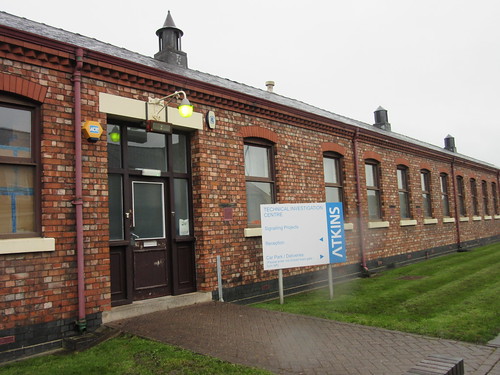 Gresty Road showing Technical Investigation Centre for Signalling Projects operated by the consultants 'Atkins'.
Gresty Road showing Technical Investigation Centre for Signalling Projects operated by the consultants 'Atkins'.
The next group of LNWR buildings are now part of the extensive Unipart Rail site. Opposite, the road leading into a housing estate is called 'Claughton Avenue'. Bowen-Cooke's 4-cylinder 4-6-0 class was introduced in 1913, but named after the then-chairman of the LNWR, Sir Gilbert Claughton (1856-1921)
 Gresty Road showing entrance to Unipart Rail.
Gresty Road showing entrance to Unipart Rail.
I remember when Technical Investigations at Crewe were still part of British Rail. Most of the British Rail signalling workshops were initially privatised as N.R.S. (National Railway Supplies) but it now forms Unipart Rail.
Before turning back, I came to YMCA Crewe. I don't know the history of this modernised building but it certainly looks as if it could have served as a locomens' lodge or similar. Can anyone enlighten me, please?
 YMCA Crewe in Gresty Road.
YMCA Crewe in Gresty Road.
On my walk back to the station, I tried, unsuccessfully, to get a better view of a complete British Railways standard design signal box and colour light signals on the Unipart Rail site, presumably part of a training facility. But I could read the sign on an adjacent training room:-
Approaching the station, I was joined by large numbers of people I guessed were about to join the steam special. I made my way to platform 9 for the 09:23 DMU to Chester, noting that the steam special was due to follow my train after 6 minutes. Maroon-liveried 'West Coast' stock was standing in platform 12 and 'Royal Scot' with its "blood-and-custard" support coach had already drawn forward onto the Down Chester, awaiting the signal to set back onto the train. After a short pause, 'Royal Scot' backed onto its train, sporting a rather 'posh' storm sheet between the trailing edge of the cab roof and the tender.
 'Royal Scot' (and support coach) backs onto its train in platform 12.
'Royal Scot' (and support coach) backs onto its train in platform 12.
My 2-car DMU arrived and a lot of passengers got off. Then a lot of passengers, including me, got on and we were soon under way for the trip to Chester, where we arrived in the bay platform. A Manchester - Llandudno train was expected in a few minutes, so I positioned myself on platform 3B (the western end of the long down through platform) ready to board the connection and I was soon under way again. I noticed a significant police presence on the station, which was probably due to the following steam train. The middle aged men with cameras hanging around were certainly there for 'Royal Scot'.
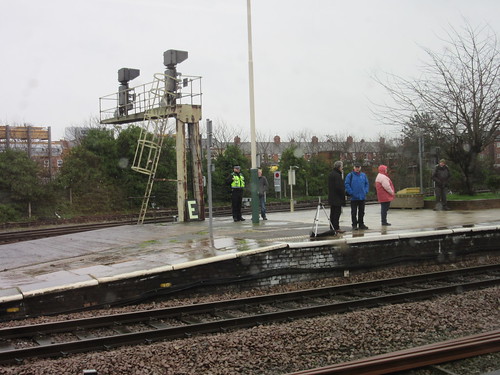 Chester station, waiting for 'Royal Scot' on the Holyhead Private Charter.
Chester station, waiting for 'Royal Scot' on the Holyhead Private Charter.
These enthusiasts could also be seen as I continued to Llandudno Junction, despite the inclement weather, not just at stations but also at various farm gates along the line. I'm afraid I didn't see the steam special again myself after leaving Crewe.
When we paused at Shotton Low Level, I was interested to see rodent traps deployed, because I'd noticed these at Shotton High Level on an earlier trip (8th March 2014), described here.

Shotton Low Level Up Platform (with what appears to be a rodent trap at the base of the lamp post).
We made our scheduled stop at Fflint (more enthusiasts), sped past the now very sad looking 'Duke of Lancaster' (which still has a website here), stopped at Prestatyn then Rhyl. The line is only double track now but a number of signal structures remain cantilevered 2-doll brackets which originally served the 4-track route, now equipped with just one arm. Distant signals are a mixture of colour light and semaphore.
 The beached 'Duke of Lancaster'.
The beached 'Duke of Lancaster'.
Beyond Rhyl, we hurried through Abergele in the rain without stopping. When I was young, I always thought this a romantic railway location - four-track with platforms flanking the outer slow lines, Camping Coaches on the seaward side and a dignified LNWR signal box in the middle of it all. Now, it's just 2-track but the down line throws off a loop to the platform line. The facing points leading to the down loop are controlled by two rodding runs - one for the Facing Point Lock, one for the points themselves. The trailing points just need one rodding run to operate the points. Signals around the station remain LMS upper-quadrant. There's a series of posts in this blog about British railway signalling, starting here. Mechanical Operation of Points is described in Part 6. I'm happy to report that, for some reason, the signal box has avoided the worst of the structural alterations I usually complain about and, whilst there are external changes, it looked 'right' (at least from some vantage points). I spotted the expected contingent of steam enthusiasts sheltering under the awning on the Up platform, waiting for 'Royal Scot'.
We stopped briefly at Colwyn Bay which has lost two of the four platforms I remember,together with some of its station buildings, its LNWR glazed screens and is no longer a block post. Between Colwyn Bay and Llandudno Junction, the line was quadruple from 1904 to the 1980s, when it reverted to double track and the A55 Expressway took over the freed-up land. This section of line has a place in railway history for two reasons, which I'll cover in a later post.
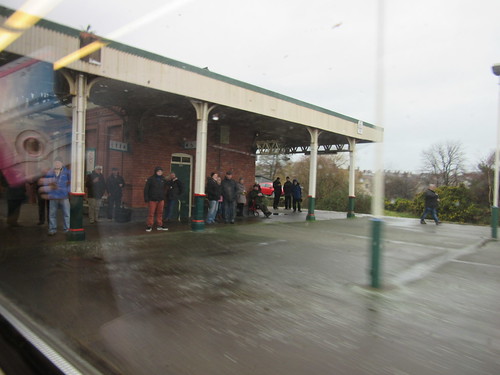 Stopping at Llandudno Junction. Note the steam enthusiasts awaiting the arrival of the following 'Royal Scot'.
Stopping at Llandudno Junction. Note the steam enthusiasts awaiting the arrival of the following 'Royal Scot'.
After another brief stop at 'The Junction', we were soon underway on the final, short leg of our journey. Deganwy is now shown as a 'request stop', and we sailed right through on this occasion.
It was still raining when I got off the train at Llandudno but, undaunted, I set off on foot along Vaughan street to the promenade, crossing the end of the main Victorian shopping street, Mostyn Street, at the delightfully named 'North Western Gardens'.
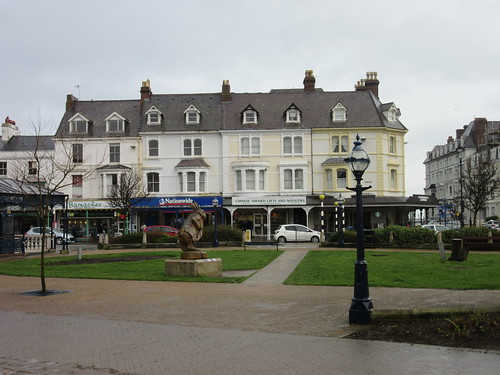 View across North Western Gardens showing the canopied shops in Mostyn Street.
View across North Western Gardens showing the canopied shops in Mostyn Street.
The modern shopping centre, with its large car park, lay a few yards on my right - I don't believe I've ever visited it. Arriving at the promenade near the Imperial Hotel, the curve of the bay between the Little Orme and Great Orme headlands, with the wide pedestrian promenade and the arc of hotels facing the sea, captivated me, as it always has. I happily walked along the promenade towards the pier.
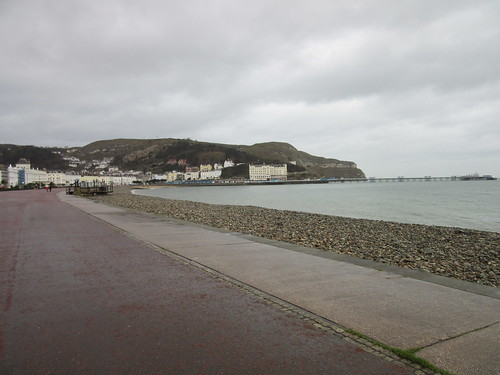 Llandudno: The Promenade looking towards the Great Orme, with the pier on the right.
Llandudno: The Promenade looking towards the Great Orme, with the pier on the right.
Much of the beach is shingle but, near the War Memorial, there is often a sandy stretch until the tide comes in which I was happy to share for a while with a few children and dogs. I then headed away from the sea via St. George's Place, crossed Mostyn Street and continued along Lloyd street to the Town Hall, where the local 'Lions Club' were holding a charity Antiques Fair which I decided to support.
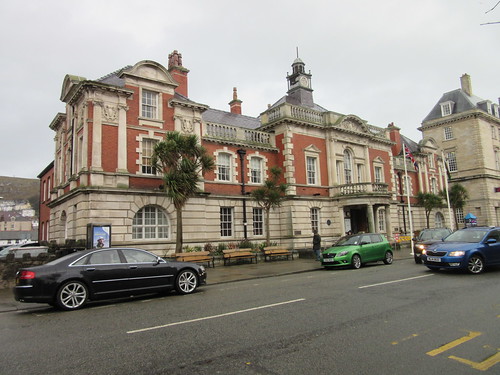 Llandudno: The Town Hall.
Llandudno: The Town Hall.
On one stall, I was surprised to find two black-and-white framed locomotive photographs which I recognised as North British works photographs. One was 'Royal Scot' as built and I commented to the stallholder that I'd seen that very engine (in its rebuilt form) a little earlier. I resisted the strong temptation to purchase it, instead selecting the picture of ill-fated 6399 'Fury'. This experiment in the use of high-pressure steam was abandoned and the locomotive was rebuilt as a conventional 'Royal Scot'.
Near the Town Hall is the famous fish and chip restaurant 'Tribells' so I decided to try their take-away service. Both fish and chips were cooked while I waited (reminding me of fish and chips I had in Sydney on my Round the World One trip in 2001). I started to eat as I walked back to the prom and then sat watching the grey sea. The rain had stopped and the food was excellent. Two seagulls patiently waited on the tarmac a few feet away as I ate - a bit different from a few years ago when they would 'dive-bomb' for food. In view of their good manners, I allowed a small piece of fish to fall as I disposed of the polystyrene tray in a litter bin. I later found notices warning against feeding and littering but there was certainly no litter left!
I made my way back to Mostyn Street to look at some of the shops. Opposite Marks and Spencers, there's the Victoria Centre with its roof-top car park. It's cod-Victorian, not real but does capture some of the atmosphere of the original Victorian shopping arcades, so I don't object to it too much. Many of the shops along Mostyn Street retain Victorian canopies over the pavement (with various degrees of modernisation to keep them watertight). I was soon drawn back to the Promenade and decided to patronise the covered terrace restaurant at the Imperial Hotel, where I enjoyed a toasted teacake and a pot of tea tea with panoramic views of the sea.
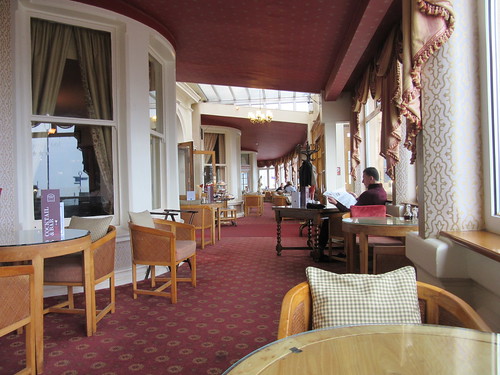 The Terrace at the Imperial Hotel.
The Terrace at the Imperial Hotel.
I'd made a note of trains back to Wolverhampton in time to let me take a bus back to my village, so I reluctantly stirred myself from the Imperial and made the walk to the station, which took around ten minutes. The LNWR station buildings have been quite tastefully modernised, so I took a few pictures before joining the waiting train - a 3-coach 'Class 175' only going to Llandudno Junction before returning to Llandudno.
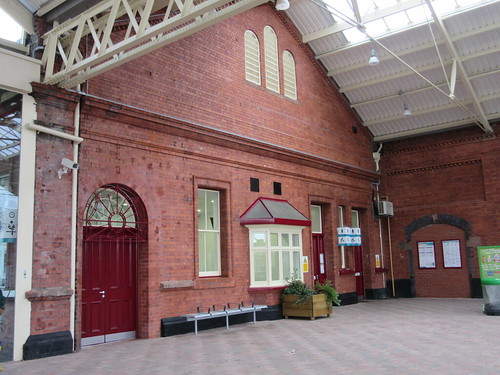 The modernised concourse at Llandudno station.
The modernised concourse at Llandudno station.
I boarded at the front of the train and noticed that the cab door was open, because the Driver was in the passenger section chatting to another railwayman. The friendly driver readily agreed to my taking a couple of pictures of the cab before he left.
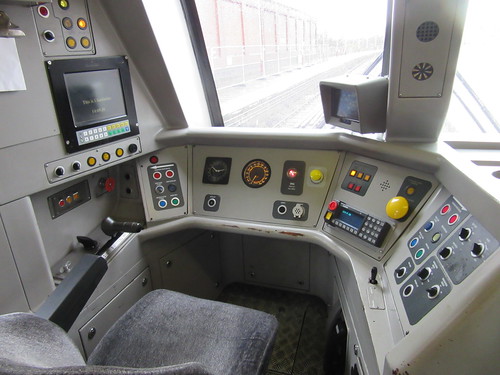 Cab View of 'Class 175' at Llandudno station.
Cab View of 'Class 175' at Llandudno station.
This time, we paused at Deganwy and I took a rather grey picture of Conwy and its ancient castle as we departed. There's a bit about Conwy, its river bridges and castle in my post Trip to Holyhead (Part 2: Llandudno to Holyhead).
 Conwy viewed from Deganwy.
Conwy viewed from Deganwy.
I only had a few minutes to wait before my connection arrived - a 2-car multiple unit which made a few stops before Chester. Here, I had a choice - I could stay on the train which reversed at Chesterand took the former Great Western Railway route through Wrexham and Shrewsbury, calling at Wolverhampton before continuing to Birmingham International. The alternative was a Virgin Voyager service to Crewe, changing to a London Midland Electric Multiple Unit to Wolverhampton. The cheerful Welsh lady Conductor/Guard, having checked my ticket, used her portable ticket issuing machine to confirm the timings via Crewe. She recommended staying on her train, which would arrive at Wolverhampton only about five minutes later than the alternative involving two changes.
But, of course, with my allegiance to the "Nor'Wessie" and its successor the L.M.S., I chose to change at Chester and Crewe. Although I was getting fairly tired, I managed a few more pictures of the imposing station buildings at Chester, before boarding the 'Quiet Coach' at the rear of the Virgin 'Voyager' already waiting in platform 4.
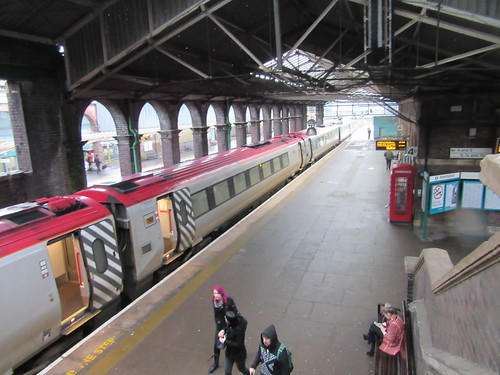 Virgin 'Voyager' from Holyhead to London at Chester.
Virgin 'Voyager' from Holyhead to London at Chester.
Fortunately, the rest of the journey back to Wolverhampton worked well, the bus was on time, so I was back home happy but fairly exhausted. The next day, I was on the footplate at Peak Rail!
Book References
[ 1] '‘British Railways Layout Plans of the 1950’s - Volume 1: ex-LNWR main line, Euston to Crewe’ (Signalling Record Society) ISBN: 1 873228 00 7.
[ 2] ‘British Railways Layout Plans of the 1950’s - Volume 10: LNW Lines in North Wales, Chester and Wirral areas’ (Signalling Record Society) ISBN: 1-873228-12-0.
[ 3] 'An Historical Survey of Chester to Holyhead Railway Track Layouts and Illustrations' by V. R. Anderson and G. K. Fox (Oxford Publishing Co.) ISBN 0 86093 216 8.
[ 4] ‘Along LMS Routes’ by Bill Hudson, Volume 1 Central & Western Divisions (Headstock Publications) ISBN 0 9512793 4 3.
Related articles in this blog
A Trip to the Seaside (Part 1).
A Trip to the Seaside (Part 2).
Trip to Holyhead (Part 1: Crewe to Llandudno).
Trip to Holyhead (Part 2: Llandudno to Holyhead).
The Holyhead to Crewe Railway Line.
Llandudno.
Llandudno Railway Station.
My pictures
Stafford Area rail.
Crewe Area rail.
North Wales Line (Crewe - Llandudno).
Llandudno (pictures around the town).
Events of Saturday 6th February 2016
By train to Llandudno
Although it was raining quite hard at home when I got up, I decided I would take the first bus to Wolverhampton and travel to Llandudno (a favourite destination) by train.
The first departure from Wolverhampton was an Arriva Cross Country to Manchester which I took as far as Stafford. Whilst waiting for the following London Midland Liverpool train, I was able to study the historical pictures displayed in the waiting room.
 A 1938 view of the north end of Stafford, with the Wellington line (long gone) curving to the left, the four tracks to Crewe in the centre and the Uttoxeter line (long gone) curving to the right.
A 1938 view of the north end of Stafford, with the Wellington line (long gone) curving to the left, the four tracks to Crewe in the centre and the Uttoxeter line (long gone) curving to the right.
The London Midland Class 350 made good time to Crewe. As we slowed down into platform 11, I spotted a steam locomotive outside the Locomotive Storage building. From the brief glimpse, I took it to be 'Royal Scot', which I later confirmed. Since I had a while to wait before my connection to Chester, I decided to have a walk down Gresty Road (it was still raining hard). Leaving the station, there was smoke rising from the north side of the Nantwich Road bridge, so the steam locomotive had apparently moved down, ready to shunt onto its steam special train.
When I first visited Gresty Road, it was home to British Railways Signal Workshops, housed mainly in various LNWR-built buildings. I had a number of business meetings here when we were supplying telecommunication systems to the railways (briefly described here and here).
The first long block of offices I came to was typically LNWR - functional yet pleasing. I discovered it's now the Technical Investigation Centre for Signalling Projects operated by the consultants 'Atkins' (who have succumbed to replacing the 'A' in 'Atkins' with an upside-down capital 'V', following the same illiterate convention as the car company 'Kia' which I complained about in the post By Rail to Guildford. In case mis-spelling 'Atkins' fails to confuse the visitor sufficiently, they've also turned the whole name through 90 degrees on the sign).
 Gresty Road showing Technical Investigation Centre for Signalling Projects operated by the consultants 'Atkins'.
Gresty Road showing Technical Investigation Centre for Signalling Projects operated by the consultants 'Atkins'.
The next group of LNWR buildings are now part of the extensive Unipart Rail site. Opposite, the road leading into a housing estate is called 'Claughton Avenue'. Bowen-Cooke's 4-cylinder 4-6-0 class was introduced in 1913, but named after the then-chairman of the LNWR, Sir Gilbert Claughton (1856-1921)
 Gresty Road showing entrance to Unipart Rail.
Gresty Road showing entrance to Unipart Rail.
I remember when Technical Investigations at Crewe were still part of British Rail. Most of the British Rail signalling workshops were initially privatised as N.R.S. (National Railway Supplies) but it now forms Unipart Rail.
Before turning back, I came to YMCA Crewe. I don't know the history of this modernised building but it certainly looks as if it could have served as a locomens' lodge or similar. Can anyone enlighten me, please?
 YMCA Crewe in Gresty Road.
YMCA Crewe in Gresty Road.
On my walk back to the station, I tried, unsuccessfully, to get a better view of a complete British Railways standard design signal box and colour light signals on the Unipart Rail site, presumably part of a training facility. But I could read the sign on an adjacent training room:-
Welcome to theFor more on 'the Unipart Way', look here.
FACULTY ON THE FLOOR
This is where we ..
..learn to use and improve the principles, systems, tools and techniques of the Unipart Way, access best practice developed elsewhere, and develop new ideas and coach each other in their use.
Approaching the station, I was joined by large numbers of people I guessed were about to join the steam special. I made my way to platform 9 for the 09:23 DMU to Chester, noting that the steam special was due to follow my train after 6 minutes. Maroon-liveried 'West Coast' stock was standing in platform 12 and 'Royal Scot' with its "blood-and-custard" support coach had already drawn forward onto the Down Chester, awaiting the signal to set back onto the train. After a short pause, 'Royal Scot' backed onto its train, sporting a rather 'posh' storm sheet between the trailing edge of the cab roof and the tender.
 'Royal Scot' (and support coach) backs onto its train in platform 12.
'Royal Scot' (and support coach) backs onto its train in platform 12.
My 2-car DMU arrived and a lot of passengers got off. Then a lot of passengers, including me, got on and we were soon under way for the trip to Chester, where we arrived in the bay platform. A Manchester - Llandudno train was expected in a few minutes, so I positioned myself on platform 3B (the western end of the long down through platform) ready to board the connection and I was soon under way again. I noticed a significant police presence on the station, which was probably due to the following steam train. The middle aged men with cameras hanging around were certainly there for 'Royal Scot'.
 Chester station, waiting for 'Royal Scot' on the Holyhead Private Charter.
Chester station, waiting for 'Royal Scot' on the Holyhead Private Charter.
These enthusiasts could also be seen as I continued to Llandudno Junction, despite the inclement weather, not just at stations but also at various farm gates along the line. I'm afraid I didn't see the steam special again myself after leaving Crewe.
When we paused at Shotton Low Level, I was interested to see rodent traps deployed, because I'd noticed these at Shotton High Level on an earlier trip (8th March 2014), described here.

Shotton Low Level Up Platform (with what appears to be a rodent trap at the base of the lamp post).
We made our scheduled stop at Fflint (more enthusiasts), sped past the now very sad looking 'Duke of Lancaster' (which still has a website here), stopped at Prestatyn then Rhyl. The line is only double track now but a number of signal structures remain cantilevered 2-doll brackets which originally served the 4-track route, now equipped with just one arm. Distant signals are a mixture of colour light and semaphore.
 The beached 'Duke of Lancaster'.
The beached 'Duke of Lancaster'.
Beyond Rhyl, we hurried through Abergele in the rain without stopping. When I was young, I always thought this a romantic railway location - four-track with platforms flanking the outer slow lines, Camping Coaches on the seaward side and a dignified LNWR signal box in the middle of it all. Now, it's just 2-track but the down line throws off a loop to the platform line. The facing points leading to the down loop are controlled by two rodding runs - one for the Facing Point Lock, one for the points themselves. The trailing points just need one rodding run to operate the points. Signals around the station remain LMS upper-quadrant. There's a series of posts in this blog about British railway signalling, starting here. Mechanical Operation of Points is described in Part 6. I'm happy to report that, for some reason, the signal box has avoided the worst of the structural alterations I usually complain about and, whilst there are external changes, it looked 'right' (at least from some vantage points). I spotted the expected contingent of steam enthusiasts sheltering under the awning on the Up platform, waiting for 'Royal Scot'.
We stopped briefly at Colwyn Bay which has lost two of the four platforms I remember,together with some of its station buildings, its LNWR glazed screens and is no longer a block post. Between Colwyn Bay and Llandudno Junction, the line was quadruple from 1904 to the 1980s, when it reverted to double track and the A55 Expressway took over the freed-up land. This section of line has a place in railway history for two reasons, which I'll cover in a later post.
 Stopping at Llandudno Junction. Note the steam enthusiasts awaiting the arrival of the following 'Royal Scot'.
Stopping at Llandudno Junction. Note the steam enthusiasts awaiting the arrival of the following 'Royal Scot'.
After another brief stop at 'The Junction', we were soon underway on the final, short leg of our journey. Deganwy is now shown as a 'request stop', and we sailed right through on this occasion.
It was still raining when I got off the train at Llandudno but, undaunted, I set off on foot along Vaughan street to the promenade, crossing the end of the main Victorian shopping street, Mostyn Street, at the delightfully named 'North Western Gardens'.
 View across North Western Gardens showing the canopied shops in Mostyn Street.
View across North Western Gardens showing the canopied shops in Mostyn Street.
The modern shopping centre, with its large car park, lay a few yards on my right - I don't believe I've ever visited it. Arriving at the promenade near the Imperial Hotel, the curve of the bay between the Little Orme and Great Orme headlands, with the wide pedestrian promenade and the arc of hotels facing the sea, captivated me, as it always has. I happily walked along the promenade towards the pier.
 Llandudno: The Promenade looking towards the Great Orme, with the pier on the right.
Llandudno: The Promenade looking towards the Great Orme, with the pier on the right.
Much of the beach is shingle but, near the War Memorial, there is often a sandy stretch until the tide comes in which I was happy to share for a while with a few children and dogs. I then headed away from the sea via St. George's Place, crossed Mostyn Street and continued along Lloyd street to the Town Hall, where the local 'Lions Club' were holding a charity Antiques Fair which I decided to support.
 Llandudno: The Town Hall.
Llandudno: The Town Hall.
On one stall, I was surprised to find two black-and-white framed locomotive photographs which I recognised as North British works photographs. One was 'Royal Scot' as built and I commented to the stallholder that I'd seen that very engine (in its rebuilt form) a little earlier. I resisted the strong temptation to purchase it, instead selecting the picture of ill-fated 6399 'Fury'. This experiment in the use of high-pressure steam was abandoned and the locomotive was rebuilt as a conventional 'Royal Scot'.
Near the Town Hall is the famous fish and chip restaurant 'Tribells' so I decided to try their take-away service. Both fish and chips were cooked while I waited (reminding me of fish and chips I had in Sydney on my Round the World One trip in 2001). I started to eat as I walked back to the prom and then sat watching the grey sea. The rain had stopped and the food was excellent. Two seagulls patiently waited on the tarmac a few feet away as I ate - a bit different from a few years ago when they would 'dive-bomb' for food. In view of their good manners, I allowed a small piece of fish to fall as I disposed of the polystyrene tray in a litter bin. I later found notices warning against feeding and littering but there was certainly no litter left!
I made my way back to Mostyn Street to look at some of the shops. Opposite Marks and Spencers, there's the Victoria Centre with its roof-top car park. It's cod-Victorian, not real but does capture some of the atmosphere of the original Victorian shopping arcades, so I don't object to it too much. Many of the shops along Mostyn Street retain Victorian canopies over the pavement (with various degrees of modernisation to keep them watertight). I was soon drawn back to the Promenade and decided to patronise the covered terrace restaurant at the Imperial Hotel, where I enjoyed a toasted teacake and a pot of tea tea with panoramic views of the sea.
 The Terrace at the Imperial Hotel.
The Terrace at the Imperial Hotel.
I'd made a note of trains back to Wolverhampton in time to let me take a bus back to my village, so I reluctantly stirred myself from the Imperial and made the walk to the station, which took around ten minutes. The LNWR station buildings have been quite tastefully modernised, so I took a few pictures before joining the waiting train - a 3-coach 'Class 175' only going to Llandudno Junction before returning to Llandudno.
 The modernised concourse at Llandudno station.
The modernised concourse at Llandudno station.
I boarded at the front of the train and noticed that the cab door was open, because the Driver was in the passenger section chatting to another railwayman. The friendly driver readily agreed to my taking a couple of pictures of the cab before he left.
 Cab View of 'Class 175' at Llandudno station.
Cab View of 'Class 175' at Llandudno station.
This time, we paused at Deganwy and I took a rather grey picture of Conwy and its ancient castle as we departed. There's a bit about Conwy, its river bridges and castle in my post Trip to Holyhead (Part 2: Llandudno to Holyhead).
 Conwy viewed from Deganwy.
Conwy viewed from Deganwy.
I only had a few minutes to wait before my connection arrived - a 2-car multiple unit which made a few stops before Chester. Here, I had a choice - I could stay on the train which reversed at Chesterand took the former Great Western Railway route through Wrexham and Shrewsbury, calling at Wolverhampton before continuing to Birmingham International. The alternative was a Virgin Voyager service to Crewe, changing to a London Midland Electric Multiple Unit to Wolverhampton. The cheerful Welsh lady Conductor/Guard, having checked my ticket, used her portable ticket issuing machine to confirm the timings via Crewe. She recommended staying on her train, which would arrive at Wolverhampton only about five minutes later than the alternative involving two changes.
But, of course, with my allegiance to the "Nor'Wessie" and its successor the L.M.S., I chose to change at Chester and Crewe. Although I was getting fairly tired, I managed a few more pictures of the imposing station buildings at Chester, before boarding the 'Quiet Coach' at the rear of the Virgin 'Voyager' already waiting in platform 4.
 Virgin 'Voyager' from Holyhead to London at Chester.
Virgin 'Voyager' from Holyhead to London at Chester.
Fortunately, the rest of the journey back to Wolverhampton worked well, the bus was on time, so I was back home happy but fairly exhausted. The next day, I was on the footplate at Peak Rail!
Book References
[ 1] '‘British Railways Layout Plans of the 1950’s - Volume 1: ex-LNWR main line, Euston to Crewe’ (Signalling Record Society) ISBN: 1 873228 00 7.
[ 2] ‘British Railways Layout Plans of the 1950’s - Volume 10: LNW Lines in North Wales, Chester and Wirral areas’ (Signalling Record Society) ISBN: 1-873228-12-0.
[ 3] 'An Historical Survey of Chester to Holyhead Railway Track Layouts and Illustrations' by V. R. Anderson and G. K. Fox (Oxford Publishing Co.) ISBN 0 86093 216 8.
[ 4] ‘Along LMS Routes’ by Bill Hudson, Volume 1 Central & Western Divisions (Headstock Publications) ISBN 0 9512793 4 3.
Related articles in this blog
A Trip to the Seaside (Part 1).
A Trip to the Seaside (Part 2).
Trip to Holyhead (Part 1: Crewe to Llandudno).
Trip to Holyhead (Part 2: Llandudno to Holyhead).
The Holyhead to Crewe Railway Line.
Llandudno.
Llandudno Railway Station.
My pictures
Stafford Area rail.
Crewe Area rail.
North Wales Line (Crewe - Llandudno).
Llandudno (pictures around the town).
Friday, 5 February 2016
Peak Rail Winter Season
In January and February, Peak Rail operates a winter timetable, running from Rowsley, through Darley Dale to Matlock Riverside. Riverside was Peak Rail's original Matlock terminus, before the extension to Matlock Town was opened in 2011 (described here). Riverside has run-round facilities (originally controlled from a ground frame released by the Single Line Train Staff and a set of hand points, now controlled from Matlock Riverside Signal Box) so the winter timetable can be operated by just one steam locomotive, running round its train at each terminus. This is like a proper branch line in the steam era so, although it's harder work, I prefer it.
The winter timetable was first introduced at the end of 2013, as I described in the posts Winter Timetable at Peak Rail and Peak Rail in early 2014.
A year later, in early 2015, I operated the winter timetable on a couple of days, as described in the post Rain, Sleet and Snow.
Events of 17th January 2016
It was snowing at home when I got up and it continued to snow on the journey. By the time I reached Peak Rail, the snow had stopped but everywhere was white over.
 Peak Rail in the Snow.
Peak Rail in the Snow.
Mike S. the fireman and Jacob S. the cleaner reported nothing frozen up and, since the locomotive had been in use the day before, the locomotive was starting to steam. So, we didn't seem to have too much to complain about. I like to view our footplate work as a tribute to the real professionals who ran the nation's steam railways under almost unimaginable conditions in the past. In the post Rain, Sleet and Snow, in referring to an earlier trip under adverse conditions described here, I quote one of my sayings "Anyone can work on the footplate in good weather. It takes an engineman to do it in bad weather."
But I had to admire a group of military re-enactors who had spent the previous night in bivouac within the trees, with only small, canvas tents for shelter. As I arrived, they were just getting up and preparing a simple breakfast.
 Peak Rail in the Snow: A group of military re-enactors after a night in tents.
Peak Rail in the Snow: A group of military re-enactors after a night in tents.
After a number of years as a fireman, Mike S. had just started training to pass out for driving so I encouraged him to do most of the oiling-round and daily examination. It's important to be methodical, so as not to omit oiling points but the driver should try to keep an open mind during examination, looking for anything out of the ordinary, not just checking items by rote. Time spent at this stage will give the driver confidence that he can carry out the booked working without interruption.
Before working the service train, we had a one hour driving experience course booked so we came 'off shed' as early as possible to move across to the platform where we would pick up our trainee driver. The snow could affect both adhesion and braking but the locomotive was handling fairly normally. To reach the platform, we had to change a number of sets of points. Changing points ('knobbing up' is a common railway slang term) involves moving one switch rail away from the stock (fixed) rail and moving the other switch rail so as to fit tightly against the other stock rail. The two switch rails are tied together by a 'point stretcher' so both switch rails are moved at once. We didn't have icing conditions so the first operation, moving one switch rail away from the stock rail was fine, simply pushing loose snow out of the way. The second operation involves squeezing a switch rail against the stock rail which, when there's snow, usually compacts snow against the stock rail preventing the switch rail from 'fitting up' properly unless snow is first cleared away from the area involved.
The first two sets of points we changed were locally operated 'Hand points'.
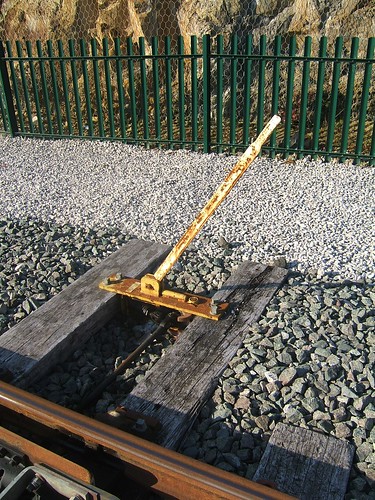
Typical point lever for Hand Points (at Matlock Town on Peak Rail).
Next, we had to 'reverse' the crossover leading to the single line which is operated from a Ground Frame released by the Single Line Token, move the locomotive onto the single line, replace the crossover to 'normal', retrieve the token and move down to the platform.
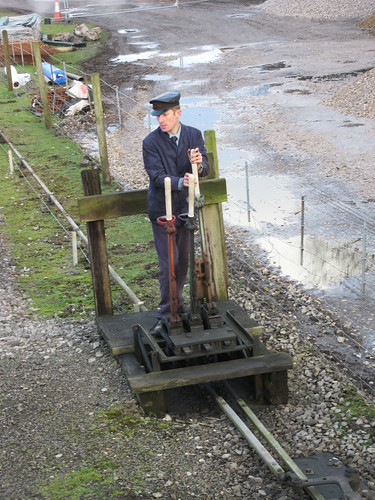
Jacob operating the South Ground Frame at Rowsley (on a day without snow!).
With all the snow clearing involved, it took a lot longer to complete the light engine move from the shed to the station than normal.
Apart from the safety issues of moving around on the ground in the snow, there are always important safety considerations when working near points - it's vital nobody has a hand or foot in the way when there's a chance somebody will attempt to operate them. With hand points, the lever is close by but with ground frames the lever may be some yards away, increasing the risk. Where points are operated from a signal box, the lever may be hundreds of yards away or, with power operation, miles away. Safety is achieved only by coming to a clear understanding with the person controlling the points before starting any work. There's a bit more information about British railway signalling in a series of posts starting here. In this series, Part 6 covers Mechanical Operation of Points.
We spent the next hour showing our driving experience candidate how to drive and fire a small locomotive.
The rest of the day was spent running four round trips to Matlock Riverside. I drove the first and last trips and let Mike drive the other two. Becoming a competent driver requires practice (and, I always say, 'fierce concentration').
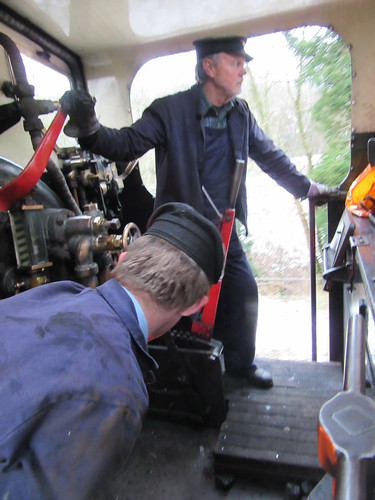
Returning to Rowsley bunker-first, with Mike driving and Jacob firing.
At the end of traffic, we took 'Lord Phil' back to shed for disposal after an enjoyable day.
Events of 24th January 2016
A week later, I was back at Peak Rail, this time without snow and with Phil M. as fireman. After a number of years as a fireman, Phil M. had also just started training to pass out for driving so I suggested that he did most of the oiling-round and locomotive examination whilst I assisted and provided hopefully helpful comments. Once again, we started with a 1-hour driving experience course which our trainee greatly enjoyed (as they usually do). I drove the first service train, let Phil drive the second and third, then I drove the last train before we came on shed to dispose. Another good day!
My pictures
Peak Rail in the Snow
The winter timetable was first introduced at the end of 2013, as I described in the posts Winter Timetable at Peak Rail and Peak Rail in early 2014.
A year later, in early 2015, I operated the winter timetable on a couple of days, as described in the post Rain, Sleet and Snow.
Events of 17th January 2016
It was snowing at home when I got up and it continued to snow on the journey. By the time I reached Peak Rail, the snow had stopped but everywhere was white over.
 Peak Rail in the Snow.
Peak Rail in the Snow.
Mike S. the fireman and Jacob S. the cleaner reported nothing frozen up and, since the locomotive had been in use the day before, the locomotive was starting to steam. So, we didn't seem to have too much to complain about. I like to view our footplate work as a tribute to the real professionals who ran the nation's steam railways under almost unimaginable conditions in the past. In the post Rain, Sleet and Snow, in referring to an earlier trip under adverse conditions described here, I quote one of my sayings "Anyone can work on the footplate in good weather. It takes an engineman to do it in bad weather."
But I had to admire a group of military re-enactors who had spent the previous night in bivouac within the trees, with only small, canvas tents for shelter. As I arrived, they were just getting up and preparing a simple breakfast.
 Peak Rail in the Snow: A group of military re-enactors after a night in tents.
Peak Rail in the Snow: A group of military re-enactors after a night in tents.
After a number of years as a fireman, Mike S. had just started training to pass out for driving so I encouraged him to do most of the oiling-round and daily examination. It's important to be methodical, so as not to omit oiling points but the driver should try to keep an open mind during examination, looking for anything out of the ordinary, not just checking items by rote. Time spent at this stage will give the driver confidence that he can carry out the booked working without interruption.
Before working the service train, we had a one hour driving experience course booked so we came 'off shed' as early as possible to move across to the platform where we would pick up our trainee driver. The snow could affect both adhesion and braking but the locomotive was handling fairly normally. To reach the platform, we had to change a number of sets of points. Changing points ('knobbing up' is a common railway slang term) involves moving one switch rail away from the stock (fixed) rail and moving the other switch rail so as to fit tightly against the other stock rail. The two switch rails are tied together by a 'point stretcher' so both switch rails are moved at once. We didn't have icing conditions so the first operation, moving one switch rail away from the stock rail was fine, simply pushing loose snow out of the way. The second operation involves squeezing a switch rail against the stock rail which, when there's snow, usually compacts snow against the stock rail preventing the switch rail from 'fitting up' properly unless snow is first cleared away from the area involved.
The first two sets of points we changed were locally operated 'Hand points'.

Typical point lever for Hand Points (at Matlock Town on Peak Rail).
Next, we had to 'reverse' the crossover leading to the single line which is operated from a Ground Frame released by the Single Line Token, move the locomotive onto the single line, replace the crossover to 'normal', retrieve the token and move down to the platform.

Jacob operating the South Ground Frame at Rowsley (on a day without snow!).
With all the snow clearing involved, it took a lot longer to complete the light engine move from the shed to the station than normal.
Apart from the safety issues of moving around on the ground in the snow, there are always important safety considerations when working near points - it's vital nobody has a hand or foot in the way when there's a chance somebody will attempt to operate them. With hand points, the lever is close by but with ground frames the lever may be some yards away, increasing the risk. Where points are operated from a signal box, the lever may be hundreds of yards away or, with power operation, miles away. Safety is achieved only by coming to a clear understanding with the person controlling the points before starting any work. There's a bit more information about British railway signalling in a series of posts starting here. In this series, Part 6 covers Mechanical Operation of Points.
We spent the next hour showing our driving experience candidate how to drive and fire a small locomotive.
The rest of the day was spent running four round trips to Matlock Riverside. I drove the first and last trips and let Mike drive the other two. Becoming a competent driver requires practice (and, I always say, 'fierce concentration').

Returning to Rowsley bunker-first, with Mike driving and Jacob firing.
At the end of traffic, we took 'Lord Phil' back to shed for disposal after an enjoyable day.
Events of 24th January 2016
A week later, I was back at Peak Rail, this time without snow and with Phil M. as fireman. After a number of years as a fireman, Phil M. had also just started training to pass out for driving so I suggested that he did most of the oiling-round and locomotive examination whilst I assisted and provided hopefully helpful comments. Once again, we started with a 1-hour driving experience course which our trainee greatly enjoyed (as they usually do). I drove the first service train, let Phil drive the second and third, then I drove the last train before we came on shed to dispose. Another good day!
My pictures
Peak Rail in the Snow
Thursday, 4 February 2016
Grand Central and Birmingham New Street Station
Saturday, 3rd January 2016 was overcast and wet but I decided to made a trip to the rebuilt Birmingham New Street Station now that work was complete and the associated 'Grand Central' shopping centre was open.
Preparatory work on this major project was started in September 2009 and three and a half years later some of the the facilities were brought into use. With temporarily-narrowed platforms and limited access between the platforms and concourse level, I found passing through the station uncomfortable, as I reported in an earlier report here.
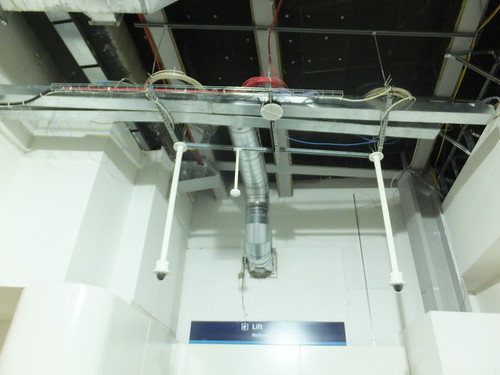 Birmingham New Street half-rebuilt in 2013. All the services are in but the false ceiling is still to be fitted.
Birmingham New Street half-rebuilt in 2013. All the services are in but the false ceiling is still to be fitted.
After a further two years of relative misery, the station was fully opened on 24th September 2015, after an expenditure some sources estimate at 750 million Pounds Sterling. Incidentally, when they did put all the false ceilings in, it's in the form of a series of vertical panels with 'wavy' edges. It appears that "modern architects abhor a straight line".
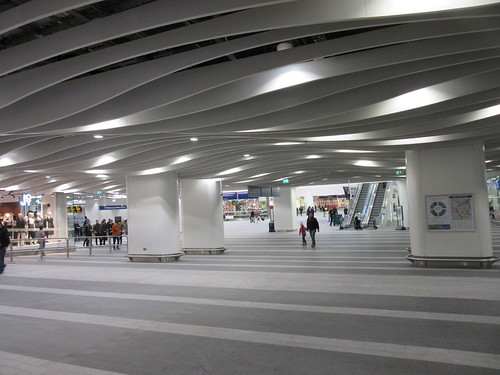 Grand Central, soon after fully opening, showing the 'wavy' false ceiling.
Grand Central, soon after fully opening, showing the 'wavy' false ceiling.
Birmingham City Council funded the rebuilding as part of the 'Gateway Plus' project but, in the meantime, a settlement of 1,100 million Pounds Sterling was awarded against the Council for equal pay claims. The National Exhibition Centre Group had already been sold for 307 million Pounds Sterling and now Grand Central is for sale.
Lead designer was Haskoll Architects and the site's 'Unique Selling Points' appear to be a reflective steel facade, a bigger concourse and, especially, 450,000 sq ft of shops. Back in 2012, the more modest claim was that the 'Pallasades' (the old shopping centre dating from when the line was being electrified) was being 'renamed'.
 Grand Central, Birmingham New Street: The much-vaunted atrium over the main shopping area.
Grand Central, Birmingham New Street: The much-vaunted atrium over the main shopping area.
The railway station
The various street entrances now available and the larger concourse with escalators, lifts and stairs provided to the subterranean platforms are a distinct improvement but the 12 through platform lines are substantially unchanged. Since the station was rebuilt in the 1960s, there has been only one alteration to platforms - the creation of a short bay at the Wolverhampton end of platform 4 called platform 4c which is used by London Midland services.
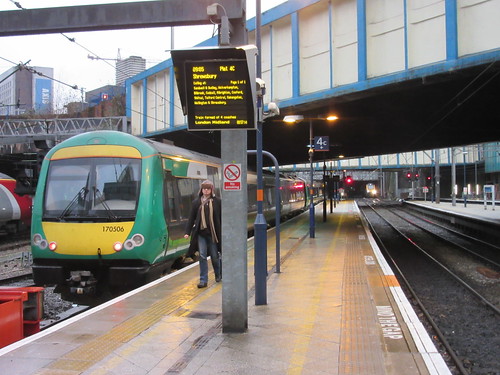 Birmingham New Street: North end of platform 4 with bay 4c (used by 'London Midland' trains) on the left.
Birmingham New Street: North end of platform 4 with bay 4c (used by 'London Midland' trains) on the left.
The main platforms are as uninviting as before, apart from the escalators, lifts and stairs plus somewhat better lighting and a 'paint job'
 Birmingham New Street: Platform 4 looking south after the opening of Grand Central.
Birmingham New Street: Platform 4 looking south after the opening of Grand Central.
Perhaps I didn't see the outside of the station at its best (it continued to rain). The reflective steel facade is certainly striking in a 'gosh - an alien space-ship has just landed' sort of way, but it certainly didn't make me think "here's an exciting place to travel from - and I can shop, too!".
 Grand Central, Birmingham New Street: The pedestrian entrance coming from the Bull Ring direction.
Grand Central, Birmingham New Street: The pedestrian entrance coming from the Bull Ring direction.
I also looked at the Hill Street pedestrian entrance. Plenty of shiny metal embraces the station but the retricted sight-lines give a rather muddled appearance.
 Grand Central, Birmingham New Street: View from Hill Street.
Grand Central, Birmingham New Street: View from Hill Street.
There's a little more on Wikipedia about Grand Central here. The history of Birmingham New Street Station is also outlined on Wikipedia here.
There's a typically 'bullish' report from Network Rail here about the redevelopment and their information pages on the station are here.
The 'Midland Metro'
The railway station will be accessible from 'Midland Metro' trams once the line is extended from the present terminus at Snow Hill, along Corporation Street to New Street station. The 127 million Pounds Sterling project should have opened in 2015 but February 2016 is currently being mooted. The tram line will then be extended past the Town Hall to Centenary Square.
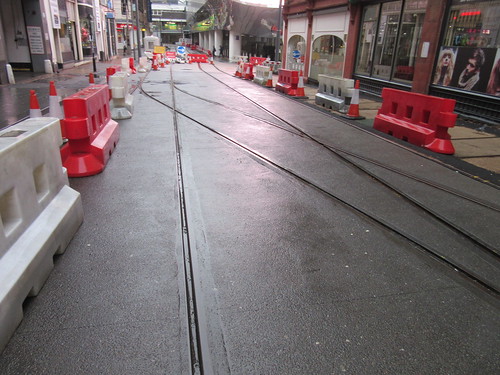 Grand Central, Birmingham New Street: The new tram lines in Stephenson Place, with the shiny cladding of the station on the right.
Grand Central, Birmingham New Street: The new tram lines in Stephenson Place, with the shiny cladding of the station on the right.
The real Grand Central
I couldn't resist this picture of the REAL Grand Central in New York, taken on my visit in 2007. There's a short report, with a link to my pictures, here, plus a bit on platform numbering here.
 The Concourse at Grand Central Terminal, New York.
The Concourse at Grand Central Terminal, New York.
Related posts on this website
Walsall by Rail ( when the station was 'half-rebuilt')
9:17 a.m. to Birmingham
My pictures
West Midland Railways.
Grand Central, Birmingham New Street.
Birmingham.
Book references
[01] ‘Birmingham New Street - Background and Beginnings’ by Richard Foster (Wild Swan Publications) ISBN 0 906867 78 9.
[02] ‘Birmingham New Street - Expansion & Improvement’ by Richard Foster (Wild Swan Publications) ISBN 0 906867 79 7.
[03] ‘Birmingham Railway Scene’ by C. C. Dorman (Town & Country Press).
[04] ‘Birmingham Railways in Old Photographs’ by Mike Hitches (Alan Sutton Publishing) ISBN 0-7509-0027-X.
[05] ‘New Street Remembered’ by Donald J. Smith (Barbryn Press Limited) ISBN 0 906160 05 7.
Preparatory work on this major project was started in September 2009 and three and a half years later some of the the facilities were brought into use. With temporarily-narrowed platforms and limited access between the platforms and concourse level, I found passing through the station uncomfortable, as I reported in an earlier report here.
 Birmingham New Street half-rebuilt in 2013. All the services are in but the false ceiling is still to be fitted.
Birmingham New Street half-rebuilt in 2013. All the services are in but the false ceiling is still to be fitted.
After a further two years of relative misery, the station was fully opened on 24th September 2015, after an expenditure some sources estimate at 750 million Pounds Sterling. Incidentally, when they did put all the false ceilings in, it's in the form of a series of vertical panels with 'wavy' edges. It appears that "modern architects abhor a straight line".
 Grand Central, soon after fully opening, showing the 'wavy' false ceiling.
Grand Central, soon after fully opening, showing the 'wavy' false ceiling.
Birmingham City Council funded the rebuilding as part of the 'Gateway Plus' project but, in the meantime, a settlement of 1,100 million Pounds Sterling was awarded against the Council for equal pay claims. The National Exhibition Centre Group had already been sold for 307 million Pounds Sterling and now Grand Central is for sale.
Lead designer was Haskoll Architects and the site's 'Unique Selling Points' appear to be a reflective steel facade, a bigger concourse and, especially, 450,000 sq ft of shops. Back in 2012, the more modest claim was that the 'Pallasades' (the old shopping centre dating from when the line was being electrified) was being 'renamed'.
 Grand Central, Birmingham New Street: The much-vaunted atrium over the main shopping area.
Grand Central, Birmingham New Street: The much-vaunted atrium over the main shopping area.
The railway station
The various street entrances now available and the larger concourse with escalators, lifts and stairs provided to the subterranean platforms are a distinct improvement but the 12 through platform lines are substantially unchanged. Since the station was rebuilt in the 1960s, there has been only one alteration to platforms - the creation of a short bay at the Wolverhampton end of platform 4 called platform 4c which is used by London Midland services.
 Birmingham New Street: North end of platform 4 with bay 4c (used by 'London Midland' trains) on the left.
Birmingham New Street: North end of platform 4 with bay 4c (used by 'London Midland' trains) on the left.
The main platforms are as uninviting as before, apart from the escalators, lifts and stairs plus somewhat better lighting and a 'paint job'
 Birmingham New Street: Platform 4 looking south after the opening of Grand Central.
Birmingham New Street: Platform 4 looking south after the opening of Grand Central.
Perhaps I didn't see the outside of the station at its best (it continued to rain). The reflective steel facade is certainly striking in a 'gosh - an alien space-ship has just landed' sort of way, but it certainly didn't make me think "here's an exciting place to travel from - and I can shop, too!".
 Grand Central, Birmingham New Street: The pedestrian entrance coming from the Bull Ring direction.
Grand Central, Birmingham New Street: The pedestrian entrance coming from the Bull Ring direction.
I also looked at the Hill Street pedestrian entrance. Plenty of shiny metal embraces the station but the retricted sight-lines give a rather muddled appearance.
 Grand Central, Birmingham New Street: View from Hill Street.
Grand Central, Birmingham New Street: View from Hill Street.
There's a little more on Wikipedia about Grand Central here. The history of Birmingham New Street Station is also outlined on Wikipedia here.
There's a typically 'bullish' report from Network Rail here about the redevelopment and their information pages on the station are here.
The 'Midland Metro'
The railway station will be accessible from 'Midland Metro' trams once the line is extended from the present terminus at Snow Hill, along Corporation Street to New Street station. The 127 million Pounds Sterling project should have opened in 2015 but February 2016 is currently being mooted. The tram line will then be extended past the Town Hall to Centenary Square.
 Grand Central, Birmingham New Street: The new tram lines in Stephenson Place, with the shiny cladding of the station on the right.
Grand Central, Birmingham New Street: The new tram lines in Stephenson Place, with the shiny cladding of the station on the right.
The real Grand Central
I couldn't resist this picture of the REAL Grand Central in New York, taken on my visit in 2007. There's a short report, with a link to my pictures, here, plus a bit on platform numbering here.
 The Concourse at Grand Central Terminal, New York.
The Concourse at Grand Central Terminal, New York.
Related posts on this website
Walsall by Rail ( when the station was 'half-rebuilt')
9:17 a.m. to Birmingham
My pictures
West Midland Railways.
Grand Central, Birmingham New Street.
Birmingham.
Book references
[01] ‘Birmingham New Street - Background and Beginnings’ by Richard Foster (Wild Swan Publications) ISBN 0 906867 78 9.
[02] ‘Birmingham New Street - Expansion & Improvement’ by Richard Foster (Wild Swan Publications) ISBN 0 906867 79 7.
[03] ‘Birmingham Railway Scene’ by C. C. Dorman (Town & Country Press).
[04] ‘Birmingham Railways in Old Photographs’ by Mike Hitches (Alan Sutton Publishing) ISBN 0-7509-0027-X.
[05] ‘New Street Remembered’ by Donald J. Smith (Barbryn Press Limited) ISBN 0 906160 05 7.
Wednesday, 3 February 2016
Flight Simulator
Click on any image below for an 'uncropped' view.
Dean had been given a birthday present piloting a flight simulator and I accompanied Ann and Dean to Birmingham Airport where SoftekSim had a 'shop' in the arrivals hall fitted with a simulator for a Beechcraft 'King Air' turbo-prop aircraft. I say "had" because, sadly, this facility closed at the end of January 2016 and it's not yet clear whether it will re-open.
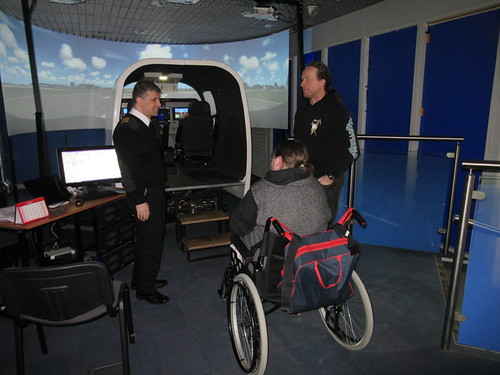 Flight Simulator: L-R: The Instructor, Ann and Dean.
Flight Simulator: L-R: The Instructor, Ann and Dean.
I was surprised to discover that the simulator was built in Latvia by SoftekSim, who are based in Riga. Although I've been a passenger in a few Beechcraft aircraft, I've not been in the upmarket King Air which the simulator represented. This was a "glass cockpit" aircraft so all the basic flying instruments were on duplicate screens in front of the Pilot (left-hand seat) and Co-pilot (right-hand seat). A larger screen in the centre displayed map information together with a host of gauges. Together with all the flying and engine controls, a host of switches and alarm annunciators, it was all pretty impressive. A large, wrap-around display outside the cockpit showed the outside world and, we soon discovered, there was realistic sound and jacks provided the appropriate motion effects.
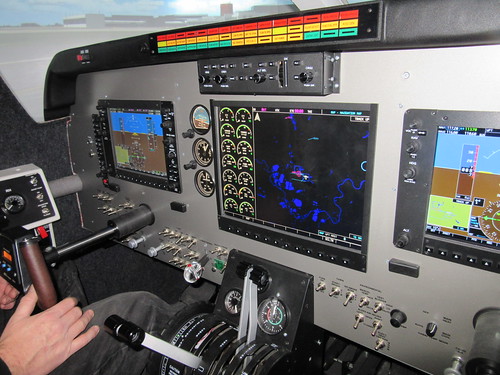 Flight Simulator.
Flight Simulator.
Dean took the left-hand seat and I squeezed into the right-hand seat, just for the ride.
The first task was to fly from London Heathrow to London City Airport in good weather. The map display and the wrap-around display showed that we were just clear of the eastern threshold of the northern runway at Heathrow, so we were going to take off to the west on runway 'Two-Seven Right'. The instructor ran briefly through some start-up checks and then had Dean start the turbo-props, producing a reassuring roar from the sound system. Power was increased and Dean taxied out, turning left (using the rudder pedals to steer on the ground) onto the runway centreline. Set take-off flap and more power, then the take-off roll commenced. The instructor prompted 'Rotate' as we achieved take-off speed and the aircraft started to climb. The instructor called for a left-hand climbing turn and, at a safe height, take-off flap setting was retracted, power was reduced and we settled into level flight heading east towards our destination.
Then, suddenly, we were nose-down, plummetting towards the ground, with the wrap-around display showing the buildings getting larger and larger! "Not your fault" shouted the instructor, hitting the main reset. As we all laughed with relief the instructor explained that they were experiencing an occasional software fault on the simulator and we'd been unlucky. This, he said, was the reason the Birmingham Airport facility was being closed, whilst the software problem was addressed in Latvia. The simulator used three computers running 'Windows' so it took a little while to re-boot.
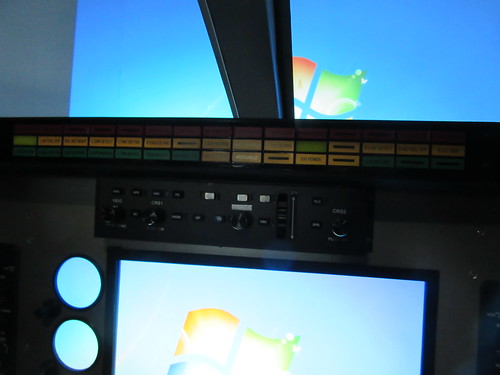 Flight Simulator: The familiar 'Windows' screen appears in the cockpit and 'outside' as the system restarts.
Flight Simulator: The familiar 'Windows' screen appears in the cockpit and 'outside' as the system restarts.
The instructor was able to position the flight at the point where the problem occurred and Dean was able to continue to 'fly' the aircraft. Overflying Canary Wharf, I had a good view of the 'O2' from my side.
 View of the 'O2' as we approached London City airport.
View of the 'O2' as we approached London City airport.
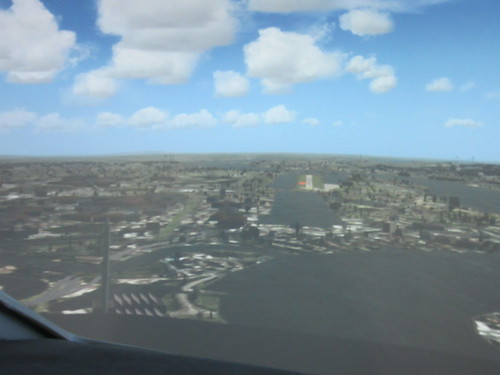 Flight Simulator: Approaching London City Airport. The 'grey' areas are water.
Flight Simulator: Approaching London City Airport. The 'grey' areas are water.
Dean safely 'let down' on the runway but had a bit of trouble steering on the ground (the 'yoke' controlling the ailerons are ineffective on the ground - only the rudder pedals work. We veered onto the grass and I was sure we we going to get a 'dunking' in the adjacent dock but Dean managed to stop just before we hit the chain link fence at the boundary. The instructor seemed quite impressed commenting "Any thing you walk away from is a 'perfect landing'".
There was time for Dean to make a second landing. This time, the instructor positioned the aircraft cruising up the valley between the mountains on the approach to Innsbruck International Airport in Tyrol, western Austria.
 Flight Simulator: The mountains around Innsbruck, Tyrol, western Austria.
Flight Simulator: The mountains around Innsbruck, Tyrol, western Austria.
This time, Dean was able to land and brake in a straight line, impressing everybody. I'm sure Dean would have happily done it all again, but the next customers were already waiting for their 'slot'.
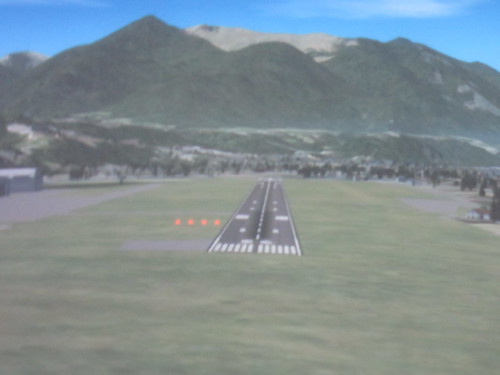 Flight Simulator: Coming in to land at Innsbruck airport.
Flight Simulator: Coming in to land at Innsbruck airport.
Despite the 'hiccup' with the computers, Ann, Dean and I were very taken with the set-up and hope that SoftekSim will be able to resume operations in the future.
My pictures
Flight Simulator.
Dean had been given a birthday present piloting a flight simulator and I accompanied Ann and Dean to Birmingham Airport where SoftekSim had a 'shop' in the arrivals hall fitted with a simulator for a Beechcraft 'King Air' turbo-prop aircraft. I say "had" because, sadly, this facility closed at the end of January 2016 and it's not yet clear whether it will re-open.
 Flight Simulator: L-R: The Instructor, Ann and Dean.
Flight Simulator: L-R: The Instructor, Ann and Dean.
I was surprised to discover that the simulator was built in Latvia by SoftekSim, who are based in Riga. Although I've been a passenger in a few Beechcraft aircraft, I've not been in the upmarket King Air which the simulator represented. This was a "glass cockpit" aircraft so all the basic flying instruments were on duplicate screens in front of the Pilot (left-hand seat) and Co-pilot (right-hand seat). A larger screen in the centre displayed map information together with a host of gauges. Together with all the flying and engine controls, a host of switches and alarm annunciators, it was all pretty impressive. A large, wrap-around display outside the cockpit showed the outside world and, we soon discovered, there was realistic sound and jacks provided the appropriate motion effects.
 Flight Simulator.
Flight Simulator.
Dean took the left-hand seat and I squeezed into the right-hand seat, just for the ride.
The first task was to fly from London Heathrow to London City Airport in good weather. The map display and the wrap-around display showed that we were just clear of the eastern threshold of the northern runway at Heathrow, so we were going to take off to the west on runway 'Two-Seven Right'. The instructor ran briefly through some start-up checks and then had Dean start the turbo-props, producing a reassuring roar from the sound system. Power was increased and Dean taxied out, turning left (using the rudder pedals to steer on the ground) onto the runway centreline. Set take-off flap and more power, then the take-off roll commenced. The instructor prompted 'Rotate' as we achieved take-off speed and the aircraft started to climb. The instructor called for a left-hand climbing turn and, at a safe height, take-off flap setting was retracted, power was reduced and we settled into level flight heading east towards our destination.
Then, suddenly, we were nose-down, plummetting towards the ground, with the wrap-around display showing the buildings getting larger and larger! "Not your fault" shouted the instructor, hitting the main reset. As we all laughed with relief the instructor explained that they were experiencing an occasional software fault on the simulator and we'd been unlucky. This, he said, was the reason the Birmingham Airport facility was being closed, whilst the software problem was addressed in Latvia. The simulator used three computers running 'Windows' so it took a little while to re-boot.
 Flight Simulator: The familiar 'Windows' screen appears in the cockpit and 'outside' as the system restarts.
Flight Simulator: The familiar 'Windows' screen appears in the cockpit and 'outside' as the system restarts.
The instructor was able to position the flight at the point where the problem occurred and Dean was able to continue to 'fly' the aircraft. Overflying Canary Wharf, I had a good view of the 'O2' from my side.
 View of the 'O2' as we approached London City airport.
View of the 'O2' as we approached London City airport.
 Flight Simulator: Approaching London City Airport. The 'grey' areas are water.
Flight Simulator: Approaching London City Airport. The 'grey' areas are water.
Dean safely 'let down' on the runway but had a bit of trouble steering on the ground (the 'yoke' controlling the ailerons are ineffective on the ground - only the rudder pedals work. We veered onto the grass and I was sure we we going to get a 'dunking' in the adjacent dock but Dean managed to stop just before we hit the chain link fence at the boundary. The instructor seemed quite impressed commenting "Any thing you walk away from is a 'perfect landing'".
There was time for Dean to make a second landing. This time, the instructor positioned the aircraft cruising up the valley between the mountains on the approach to Innsbruck International Airport in Tyrol, western Austria.
 Flight Simulator: The mountains around Innsbruck, Tyrol, western Austria.
Flight Simulator: The mountains around Innsbruck, Tyrol, western Austria.
This time, Dean was able to land and brake in a straight line, impressing everybody. I'm sure Dean would have happily done it all again, but the next customers were already waiting for their 'slot'.
 Flight Simulator: Coming in to land at Innsbruck airport.
Flight Simulator: Coming in to land at Innsbruck airport.
Despite the 'hiccup' with the computers, Ann, Dean and I were very taken with the set-up and hope that SoftekSim will be able to resume operations in the future.
My pictures
Flight Simulator.
Subscribe to:
Posts (Atom)
